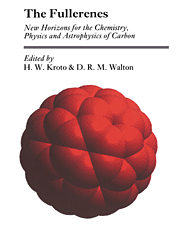Book contents
- Frontmatter
- Contents
- The evolution of the football structure for the C60 molecule: a retrospective
- Dreams in a charcoal fire: predictions about giant fullerenes and graphite nanotubes
- On the formation of the fullerenes
- Production and discovery of fullerites: new forms of crystalline carbon
- Systematics of fullerenes and related clusters
- The fullerenes: powerful carbon-based electron acceptors
- The carbon-bearing material in the outflows from luminous carbon-rich stars
- Elemental carbon as interstellar dust
- The pattern of additions to fullerenes
- Pollyynes and the formation of fullerenes
- Hypothetical graphite structures with negative gaussian curvature
- Fullerenes as an example of basic research in industry
- Deltahedral views of fullerene polymorphism
- Geodesic domes and fullerenes
The carbon-bearing material in the outflows from luminous carbon-rich stars
Published online by Cambridge University Press: 03 February 2010
- Frontmatter
- Contents
- The evolution of the football structure for the C60 molecule: a retrospective
- Dreams in a charcoal fire: predictions about giant fullerenes and graphite nanotubes
- On the formation of the fullerenes
- Production and discovery of fullerites: new forms of crystalline carbon
- Systematics of fullerenes and related clusters
- The fullerenes: powerful carbon-based electron acceptors
- The carbon-bearing material in the outflows from luminous carbon-rich stars
- Elemental carbon as interstellar dust
- The pattern of additions to fullerenes
- Pollyynes and the formation of fullerenes
- Hypothetical graphite structures with negative gaussian curvature
- Fullerenes as an example of basic research in industry
- Deltahedral views of fullerene polymorphism
- Geodesic domes and fullerenes
Summary
Within the neighbourhood of the Sun, a number of highly evolved stars are carbonrich in the sense that they have more carbon than oxygen so their outer atmospheres contain molecules such as CN, CH and C2H2. These stars are cool with atmospheric temperatures near 3000 K and they are also luminous, typically 104 times more powerful than the Sun. The outer envelopes of these stars are tenuously bound, and they all are losing mass at a very high rate, in some cases more than 10−5MOa a−1 (where MO denotes the mass of the Sun). These high luminosity carbon stars remain in this phase for a time, very approximately, near 105 years. They exhibit a large amount of carbon in their atmospheres because the products of the nuclear burning that occurs in the very centre of the star, including the synthesis of carbon, appear on the surface.
In the extended envelopes around these stars, there is a very active chemistry, and the gas is sufficiently cool that nucleation of solid dust grains occurs. These solid particles may grow to sizes as large as 1 μm although a more typical size is near 0.05 μm. We therefore can identify both relatively small carbon-bearing molecules (for example HC7N) and much larger carbon-containing dust grains in the outflows. The amount of intermediate size particles or molecules, such as C60, and their possible role in the circumstellar chemistry is not yet well understood. At least in the envelope of the well studied carbon star IRC+10216, there appears to be more carbon in CO and solid grains than in poly cyclic aromatic hydrocarbons.
- Type
- Chapter
- Information
- The FullerenesNew Horizons for the Chemistry, Physics and Astrophysics of Carbon, pp. 63 - 72Publisher: Cambridge University PressPrint publication year: 1993



